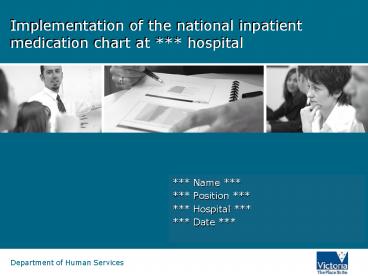Implementation of the national inpatient medication chart at hospital - PowerPoint PPT Presentation
1 / 33
Title:
Implementation of the national inpatient medication chart at hospital
Description:
43 per cent of adverse drug events preventable2 ... Patient identification: wrong patient' errors occur when ID not visible ... ordering section (high risk drug) ... – PowerPoint PPT presentation
Number of Views:106
Avg rating:3.0/5.0
Title: Implementation of the national inpatient medication chart at hospital
1
Implementation of the national inpatient
medication chart at hospital
- Name
- Position
- Hospital
- Date
2
Overview
- background
- change management strategy
- chart mechanics the how to
3
Background joint communiqué
To reduce the harm to patients from
medication errors, by June 2006, all public
hospitals will be using a common medication
chart. This means that the same chart will be
used wherever a doctor or nurse works and
wherever the patient is within a hospital.
Australian Health Ministers Conference, 23
April 2004
4
Background rationale
- drug therapy errors occur in 5-20 per cent of
drug administrations in Australian hospitals1 - 43 per cent of adverse drug events preventable2
- medication interventions save lives, reduce
length of stay, reduce admissions reduce costs3 - 1. Australian Council for Safety and
Quality in Health Care. July 2002. - 2. Wilson RM, Runciman WB, Gibberd RW
et al. Med J Aust 1995 163 458-71. - 3. Dooley MJ, Allen KM, Doecke CJ et
al. BJCP 2004 57 513.
5
Rationale errors patient harm
The Age (October 2005)
6
NIMC implementation - requirements
rationale
tools and approach
education
change
contingencies
evaluation
communication
7
Implementing change
- rationale
- Health Ministers communiqué
- standardisation of best practice in patient
safety - tools and approach
- engage project team and identify stakeholders
- clarify roles and responsibilities of team
members - establish Clinical Governance framework
- develop implementation plan
- which wards and when?
- ordering new charts / removal of old charts
- education
- who? when? how?
- integrate with existing programs
8
Implementing change
- communication
- with whom? what? how often?
- how? eg presentations, posters, flyers, website,
newsletters - evaluation
- ACSQHC Audit tool
- who? (nurse doctor/pharmacist) when? (3-6
months post) - existing performance indicators
- contingencies
- identify barriers and solutions
9
Communicating change
- Department of Human Services website
- implementation register
- change register
- issues log
- evaluation
10
- Using the chart
11
Patient identificationwrong patient errors
occur when ID not visible
- affix patient ID label on pages 3 and 4
- check labels are correct , initial
- print patient name on pages 3 and 4
12
Chart numberingaim to keep chart numbers to a
minimum to reduce risk of duplication and omission
additional charts
13
Adverse drug reactionsre-exposure is a
preventable cause of harmnot all ADRs are
clinically significant
- TICK BOX - if patient has nil known allergies or
unknown allergies status sign, print, date entry - if known ADR, note
- - drug name
- - reaction details, date of reaction sign, print
name and date entry
- if any amendments or additions made to this
section, initials and date of entry required -
attach ADR sticker to pages 3 and 4 required for
patient case notes
14
Once only, pre-medication and nurse initiated
medicinesseparate from regular medication to
reduce risk of continued administration
15
Telephone ordersimportant for rural and private
sites
- must be confirmed by second nurse
- must be countersigned by prescribing doctor
within 24 hours
16
Medications taken prior to admissionimportant
for medication reconciliation
Document medicines taken prior to presentation
section included to facilitate quick and
effective documentation of, access to
medication history
17
Regular medications variable dose section, for
example steroids and aminoglycosides
- allows ordering of medications requiring
variable dosing based on lab results or as a
reducing protocol e.g. prednisolone - for more
than once daily dosing, use a regular drug box
and follow variable dose format
18
Regular medications warfarin ordering section
(high risk drug)
- target INR indication gives decision support
info for dosing - documentation of results -
specified dose time 1600 hours - guidelines
available on target INR, duration of therapy,
dosing, managing excessive bleeding and drug
interactions
19
Regular medications
- date started not date written
- generic prescribing
- doctor to enter dosing times
- slow release box must be ticked where
appropriate - doctor contact details
- document indication useful info if drug has
different uses - route acceptable abbreviations only
20
Frequencyguidance only
21
Abbreviationsunderstood
22
Abbreviationsmisunderstood
23
Limited duration and ceased medication orders
- Limited duration
- ordered only for certain days
- block out day/times when NOT to be given
- indicate using (X)
- Ceasing medications
- must NOT be obliterated
- doctor to put single line through prescription
admin record sections - write CEASE and date
24
Reasons for not administering
Enter code and circle (ensures it wont be
misread as persons initials)
25
Additional information required
26
As required (prn) medications
Recording of Indication and Hourly frequency
for PRN medications gives clear administration
instructions and maximum daily dose
27
Results from the pilot sites (1)
28
Results from the pilot sites (2)
29
Results from the pilot sites (3)
30
Results from the pilot sites (4)
31
Summary
- changes in prescribing behaviour can occur
- opportunity to examine, identify risks and
improve medication management - keys to successful implementation were
- leadership, education, resources, willingness to
change and use as opportunity for review - until SQ commission in place state wide
jurisdictions responsible for roll out.
32
The End
- This is not the end this is just the beginning
of a nationwide move to standardising and
improving the safety of medication management
systems
33
NIMC contact details and information
Hospital Coordinator(s) Name(s)
Department(s) Email Ph Website
www.health.gov.au/vmac/projects/nimc.htm































